Scour Protection Effects of a Geotextile Mattress with Floating Plate on a Pipeline
Abstract
1. Introduction
2. Experiment Setup
2.1. Experimental Apparatus
2.2. Experimental Cases
3. Experiment Results
3.1. Verification of GMFP Protection Effects
3.2. Effects of GMFP Sloping Angle on the Averaged Seepage Hydraulic Gradient (Test Group B)
3.3. Effects of GMFP Opening Ratio on the Averaged Seepage Hydraulic Gradient (Test Group C)
3.4. Effects of GMFP Plate Height on the Averaged Seepage Hydraulic Gradient (Test Group D)
4. Discussion
4.1. Effects of GMFP Obstruction Height on the Hydraulic Gradient
4.2. Effects of the Opening Ratio on the Hydraulic Gradient
5. Conclusions
- A GMFP structure installed on the upstream side of the pipeline is capable of protecting the pipeline from scour in steady currents effectively. For all cases performed in this study, scour beneath the pipeline is successfully prevented when a GMFP is installed. The seepage hydraulic gradient in the soil under the pipeline is significantly reduced after a GMFP structure is deployed.
- The average seepage hydraulic gradient under the pipeline decreases with an increase in the sloping angle α when 0.64 < sinα < 0.77. After hitting a nadir at sinα = 0.77, the hydraulic gradient increases with the sloping angle when sinα > 0.82.
- The average seepage hydraulic gradient under the pipeline drops with the increase of the opening ratio δ when 0.167 < δ < 0.231, and then increases when δ > 0.231. The rise of hydraulic gradient with the opening ratio can be associated with the drop in the intensity of the bottom vortex.
- The average seepage hydraulic gradient under the pipeline shows a gradual decrease with increased plate height Hp, except for a fluctuation at Hp = 0.12 m.
- The average seepage hydraulic gradient has an approximate negative correlation with the obstruction area of the floating plate (Hpsinα/h0), which can be partially attributed to the extension of the bottom vortex on the leeside of the GMFP with the increase of the obstruction area.
Author Contributions
Funding
Conflicts of Interest
References
- Chiew, Y.M. Mechanics of local scour around submarine pipelines. J. Hydraul. Eng. 1990, 116, 515–529. [Google Scholar] [CrossRef]
- Sumer, B.M.; Truelsen, C.; Sichmann, T.; Fredsøe, J. Onset of scour below pipelines and self-burial. Coast. Eng. 2001, 42, 313–335. [Google Scholar] [CrossRef]
- Gao, F.; Luo, C. Flow-pipe-seepage coupling analysis of spanning initiation of a partially-embedded pipeline. J. Hydrodyn. 2010, 22, 478–487. [Google Scholar] [CrossRef]
- Chiew, Y.M. Prediction of maximum scour depth at submarine pipelines. J. Hydraul. Eng. 1991, 117, 452–466. [Google Scholar] [CrossRef]
- Haghiabi, A.H. Prediction of river pipeline scour depth using multivariate adaptive regression splines. J. Pipeline Syst. Eng. Pract. 2017, 8, 04016015. [Google Scholar] [CrossRef]
- Bui, D.T.; Shirzadi, A.; Amini, A.; Shahabi, H.; Al-Ansari, N.; Hamidi, S.; Singh, S.K.; Pham, B.T.; Ahmad, B.B.; Ghazvinei, P.T. A hybrid intelligence approach to enhance the prediction accuracy of local scour depth at complex bridge piers. Sustainability 2020, 12, 1063. [Google Scholar]
- Wu, Y.; Chiew, Y.M. Mechanics of three-dimensional pipeline scour in unidirectional steady current. J. Pipeline Syst. Eng. Pract. 2013, 4, 3–10. [Google Scholar] [CrossRef]
- Wu, Y.; Chiew, Y.M. Mechanics of pipeline scour propagation in the spanwise direction. J. Waterw. Port Coast. Ocean Eng. 2014, 141, 04014045. [Google Scholar] [CrossRef]
- Wu, Y.; Chiew, Y.M. Three-dimensional scour at submarine pipelines. J. Hydraul. Eng. 2012, 138, 788–795. [Google Scholar] [CrossRef]
- Zhu, Y.; Xie, L.; Su, T.C. Visualization tests on scour rates below pipelines in steady currents. J. Hydraul. Eng. 2019, 145, 04019005. [Google Scholar] [CrossRef]
- Fredsøe, J.; Sumer, B.M.; Arnskov, M. Time scale for wave/current scour below pipelines. Int. J. Offshore Polar Eng. 1992, 2, 13–17. [Google Scholar]
- Zang, Z.; Tang, G.; Cheng, L. Time scale of scour below submarine pipeline under combined waves and currents with oblique incident angle. In ASME 2017, Proceedings of the 36th International Conference on Ocean, Offshore and Arctic Engineering, Trondheim, Norway, 25–30 June 2017; ASME: New York, NY, USA, 2017; V009T10A019. [Google Scholar]
- Zhang, Q.; Draper, S.; Cheng, L.; An, H. Time scale of local scour around pipelines in current, waves, and combined waves and current. J. Hydraul. Eng. 2017, 143, 04016093. [Google Scholar] [CrossRef]
- Biswas, P.; Barbhuiya, A.K. Countermeasure of river bend scour using a combination of submerged vanes and riprap. Int. J. Sediment Res. 2018, 33, 478–492. [Google Scholar] [CrossRef]
- Hong, S.H.; Lee, S.O. Insight of bridge scour during extreme hydrologic events by laboratory model studies. KSCE J. Civ. Eng. 2018, 22, 2871–2879. [Google Scholar] [CrossRef]
- Lee, S.O.; Hong, S.H. Turbulence characteristics before and after scour upstream of a scaled-down bridge pier model. Water 2019, 11, 1900. [Google Scholar] [CrossRef]
- Crowhurst, A.D. Marine pipeline protection with flexible mattress. Coast. Eng. 1982, 1982, 2403–2417. [Google Scholar]
- Gaeta, M.G.; Lamberti, A.; Ricchieri, F.; Zurlo, M. Articulated concrete mattress for submarine pipeline protection: Evaluation of the wave-induced forces and stability analysis. Coast. Struct. 2013, 2, 1116–1125. [Google Scholar]
- Huang, W.; Creed, M.; Chen, F.; Liu, H.; Ma, A. Scour around submerged spur dikes with flexible mattress protection. J. Waterw. Port Coast. Ocean Eng. 2018, 144, 04018013. [Google Scholar] [CrossRef]
- Yang, C.; Xiao, P.; Zhen, B.; Shen, Z.; Li, L. Effects of vegetation cover on runoff and sediment in field prototype slope by experimental. Adv. Mat. Res. 2012, 518–523, 4707–4711. [Google Scholar] [CrossRef]
- Zhang, Z.; Shi, B.; Guo, Y.; Yang, L. Numerical investigation on critical length of impermeable plate below underwater pipeline under steady current. Sci. China Tech. Sci. 2013, 56, 1232–1240. [Google Scholar] [CrossRef]
- Chiew, Y.M. Effect of spoilers on scour at submarine pipelines. J. Hydraul. Eng. 1992, 118, 1311–1317. [Google Scholar] [CrossRef]
- Oner, A.A. Numerical investigation of flow around a pipeline with a spoiler near a rigid bed. Adv. Mech. Eng. 2016, 8, 1–13. [Google Scholar] [CrossRef]
- Zhu, L.; Liu, K.; Fan, H.; Cao, S.; Chen, H.; Wang, J.; Wang, Z. Scour beneath and adjacent to submarine pipelines with spoilers on a cohesive seabed: Case study of Hangzhou Bay, China. J. Waterw. Port Coast. Ocean Eng. 2019, 145, 05018009. [Google Scholar] [CrossRef]
- Yang, L.; Shi, B.; Guo, Y.; Zhang, L.; Zhang, J.; Han, Y. Scour protection of submarine pipelines using rubber plates underneath the pipes. Ocean Eng. 2014, 84, 176–182. [Google Scholar] [CrossRef]
- Xie, L.; Huang, W.; Yu, Y. Experimental study of sediment trapping by geotextile mattress installed with sloping curtain. Geosynth. Int. 2013, 20, 389–395. [Google Scholar] [CrossRef]
- Sumer, B.M.; Fredsoe, J. The Mechanics of Scour in the Marine Environment; World Scientific: Singapore, 2002. [Google Scholar]
- Petersen, T.U.; Sumer, B.M.; Bøgelund, J.; Yazici, A.; Fredsøe, J.; Meyer, K.E. Flow and edge scour in current adjacent to stone covers. J. Waterw. Port Coast. Ocean Eng. 2015, 141, 04014044. [Google Scholar] [CrossRef]
- Xie, L.; Zhu, Y.; Li, Y.; Su, T.C. Experimental study on bed pressure around geotextile mattress with sloping plate. PLoS ONE 2019, 14, e0211312. [Google Scholar] [CrossRef]
- Li, Y.; Yu, G. Experimental investigation on flow characteristics at leeside of suspended flexible curtain for sedimentation enhancement. China Ocean Eng. 2009, 23, 565–576. [Google Scholar]
- Xie, L.; Zhu, Y.; Su, T.C. Scour protection of partially embedded pipelines using sloping curtains. J. Hydraul. Eng. 2019, 145, 04019001. [Google Scholar] [CrossRef]
- Wang, H.; Si, F.; Lou, G.; Yang, W.; Yu, G. Hydrodynamic characteristics of a suspended curtain for sediment trapping. J. Waterw. Port Coast. Ocean Eng. 2015, 141, 04014030. [Google Scholar] [CrossRef]
- Xie, L.; Zhu, Y.; Li, H.; Li, Y.; Yang, Y.; Su, T.C. Local scour near flexible flow deflectors. Water 2020, 12, 153. [Google Scholar] [CrossRef]
- Zhu, Y.; Xie, L.; Liang, X. Scour patterns below pipelines and scour hole expansion rate. In Scour and Erosion, Proceedings of the 8th International Conference on Scour and Erosion, Oxford, UK, 12–15 September 2016; Harris, J., Whitehouse, R., Moxon, S., Eds.; CRC Press: Leiden, The Netherlands, 2016; pp. 387–394. [Google Scholar]
- Zang, Z.; Cheng, L.; Zhao, M.; Liang, D.; Teng, B. A numerical model for onset of scour below offshore pipelines. Coast. Eng. 2009, 56, 458–466. [Google Scholar] [CrossRef]
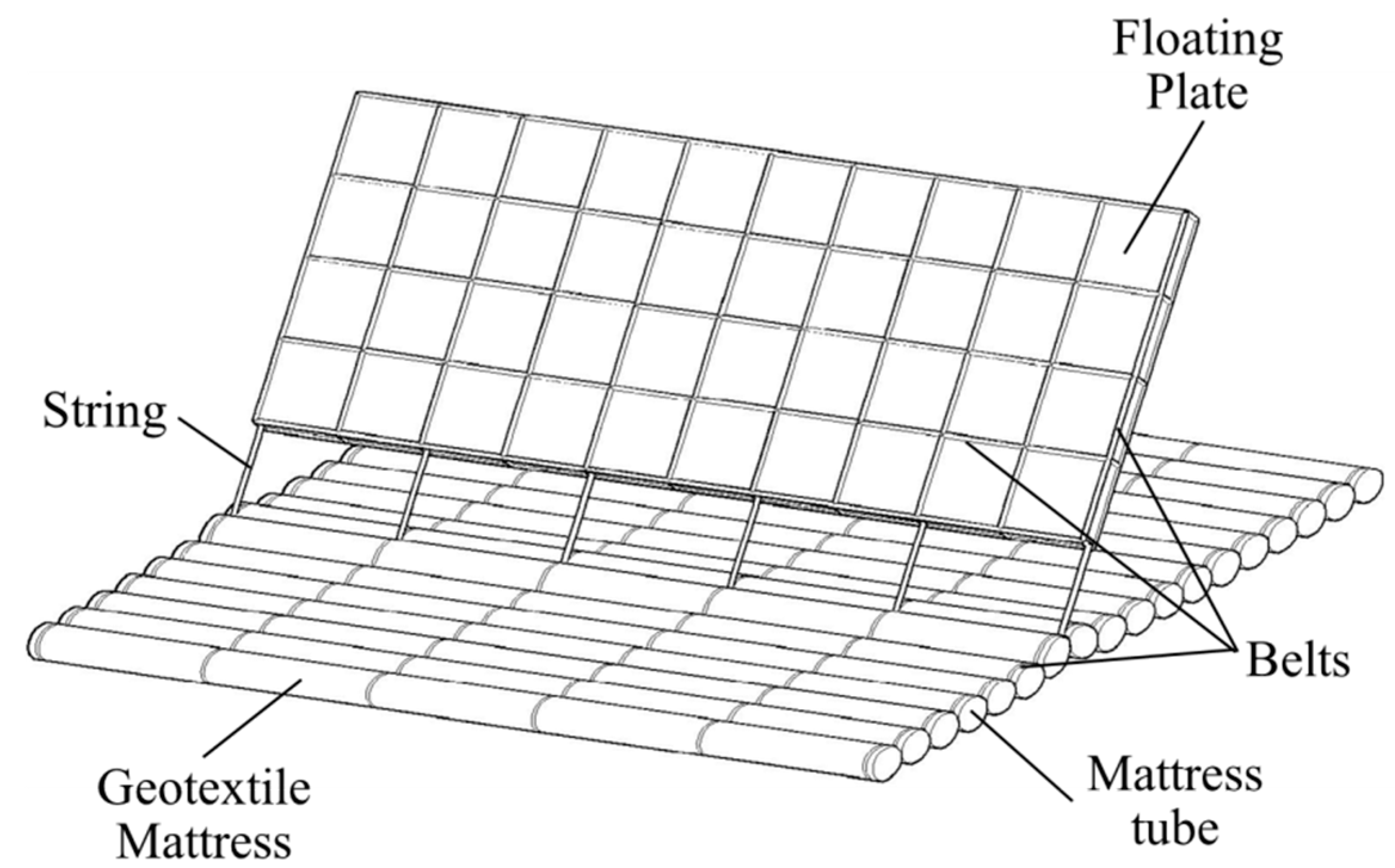
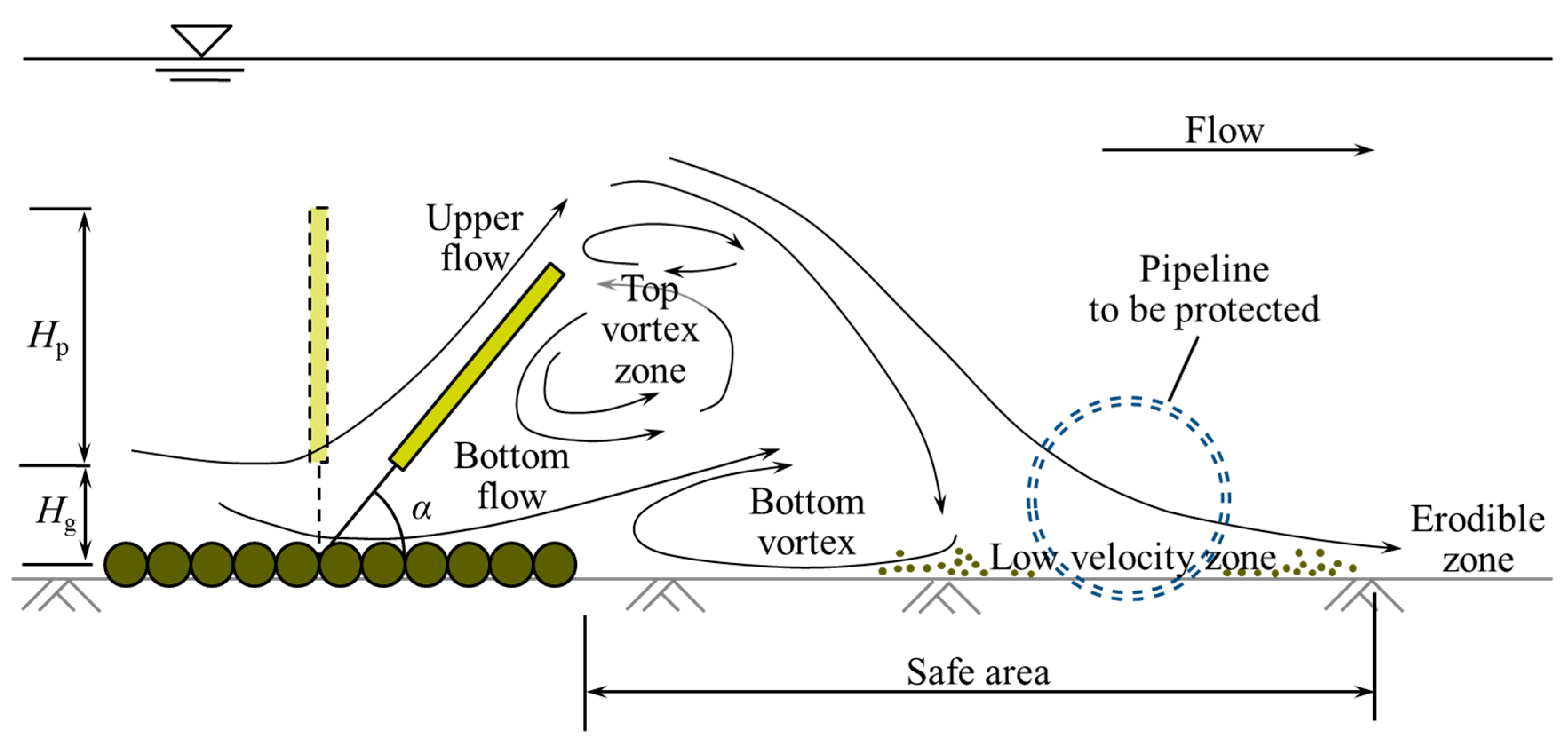
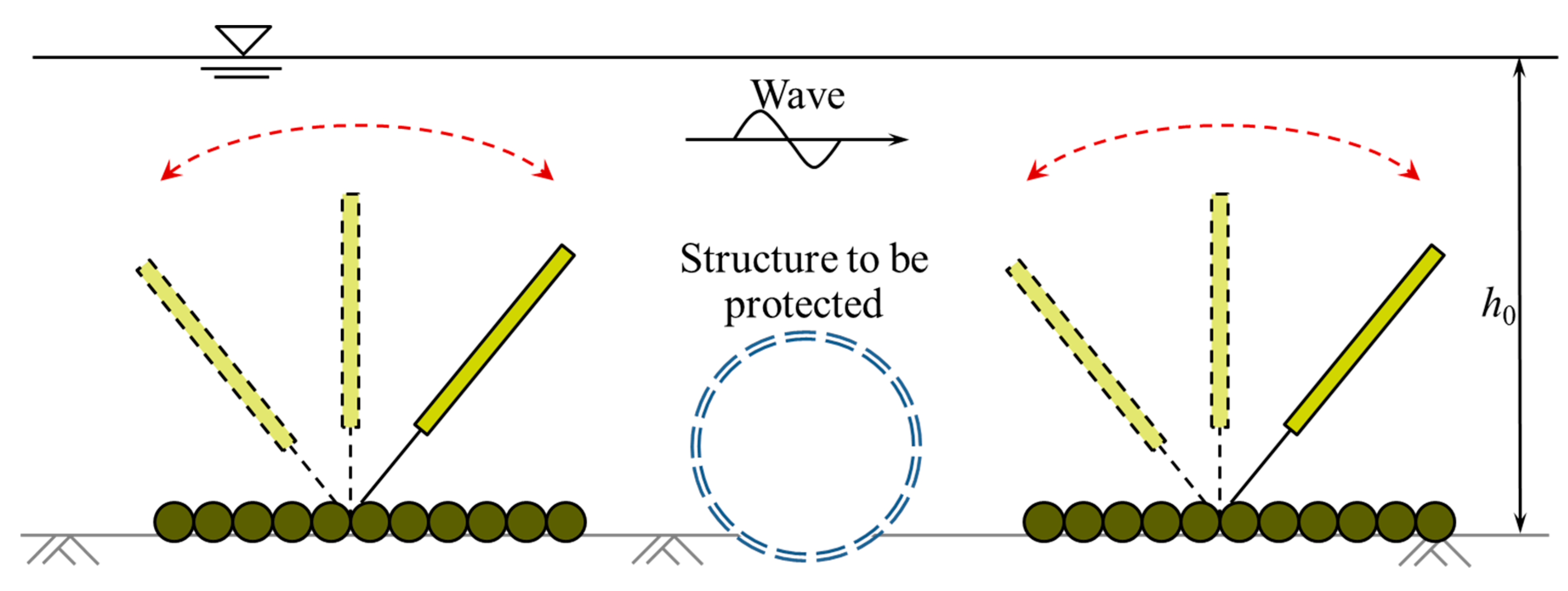
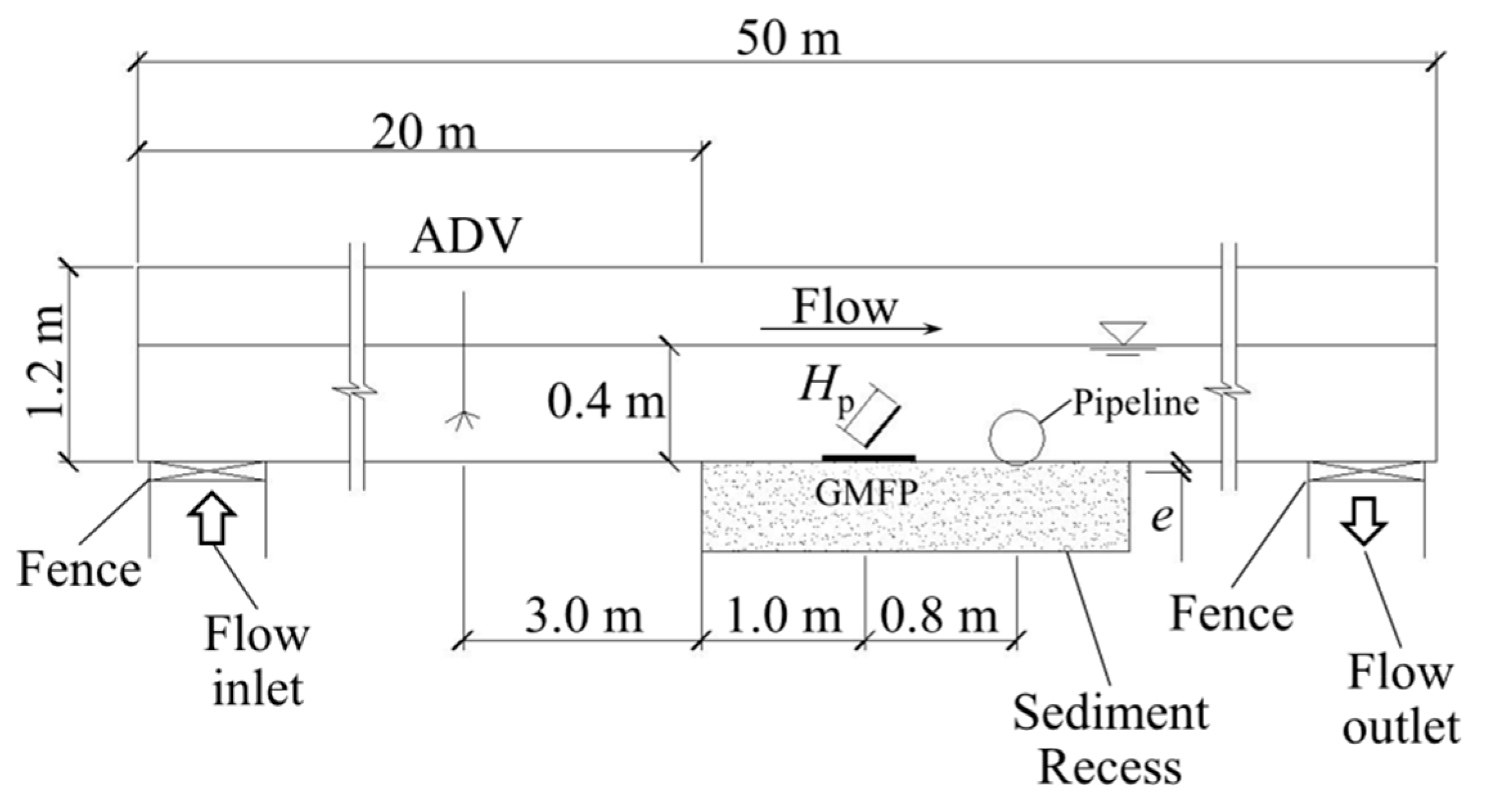
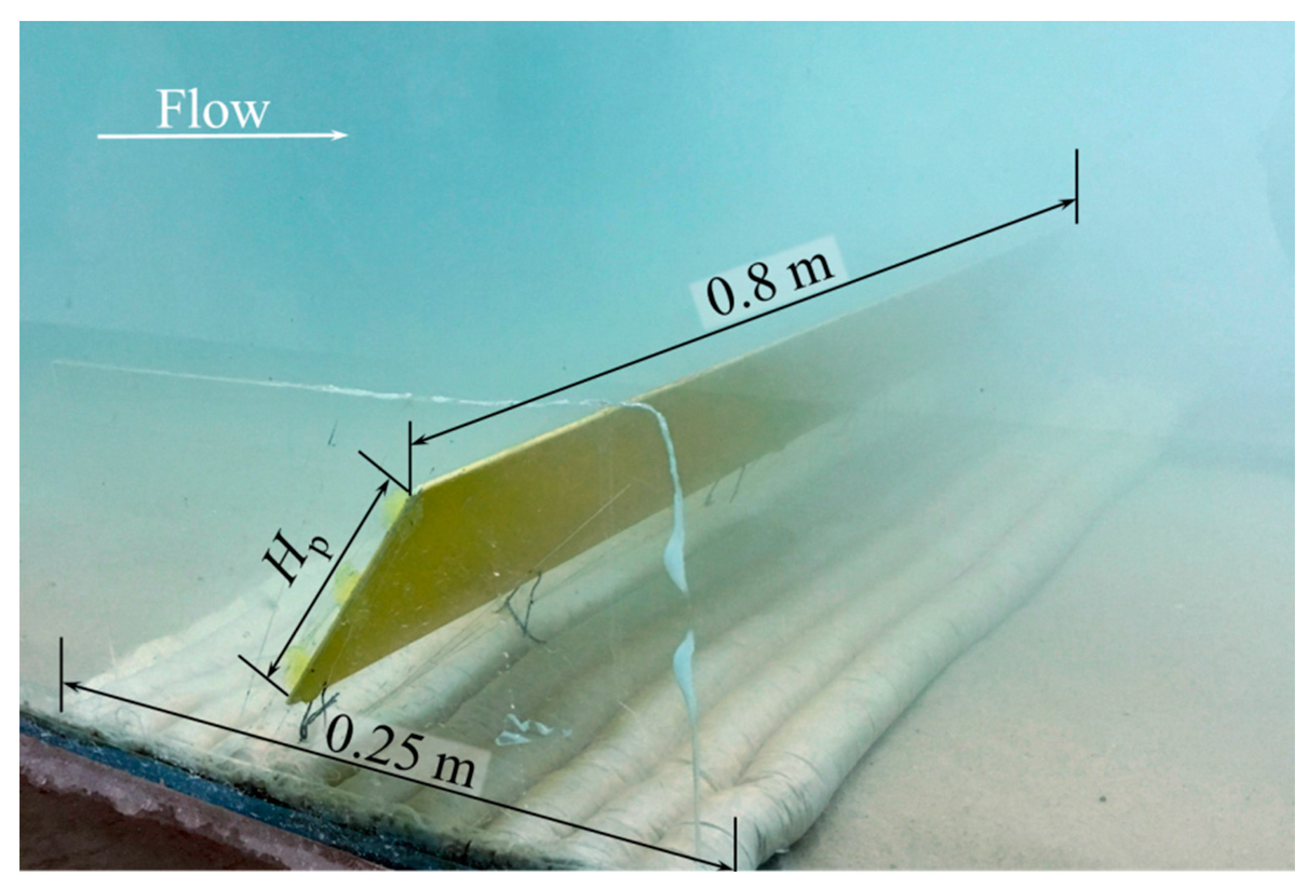
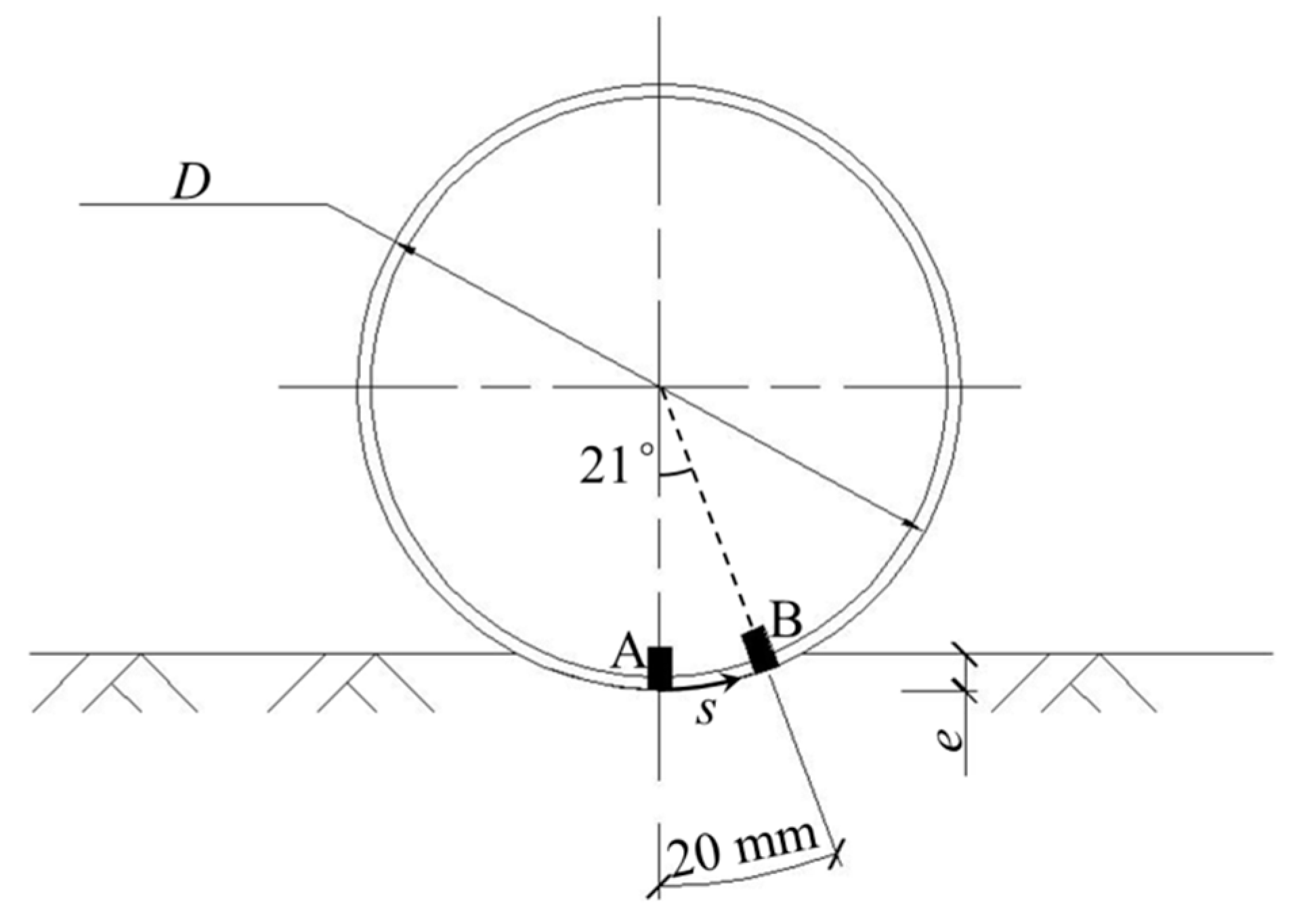
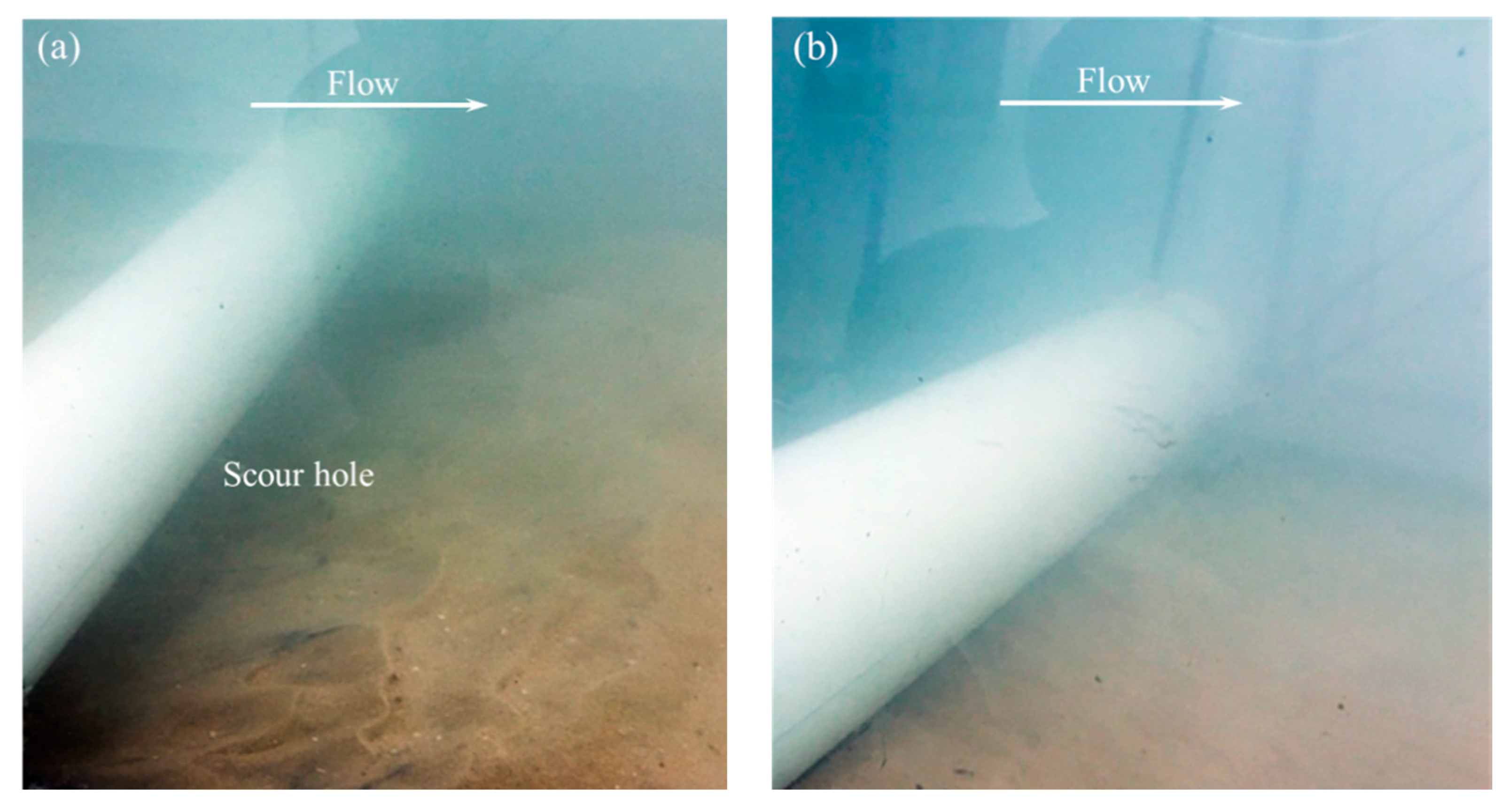
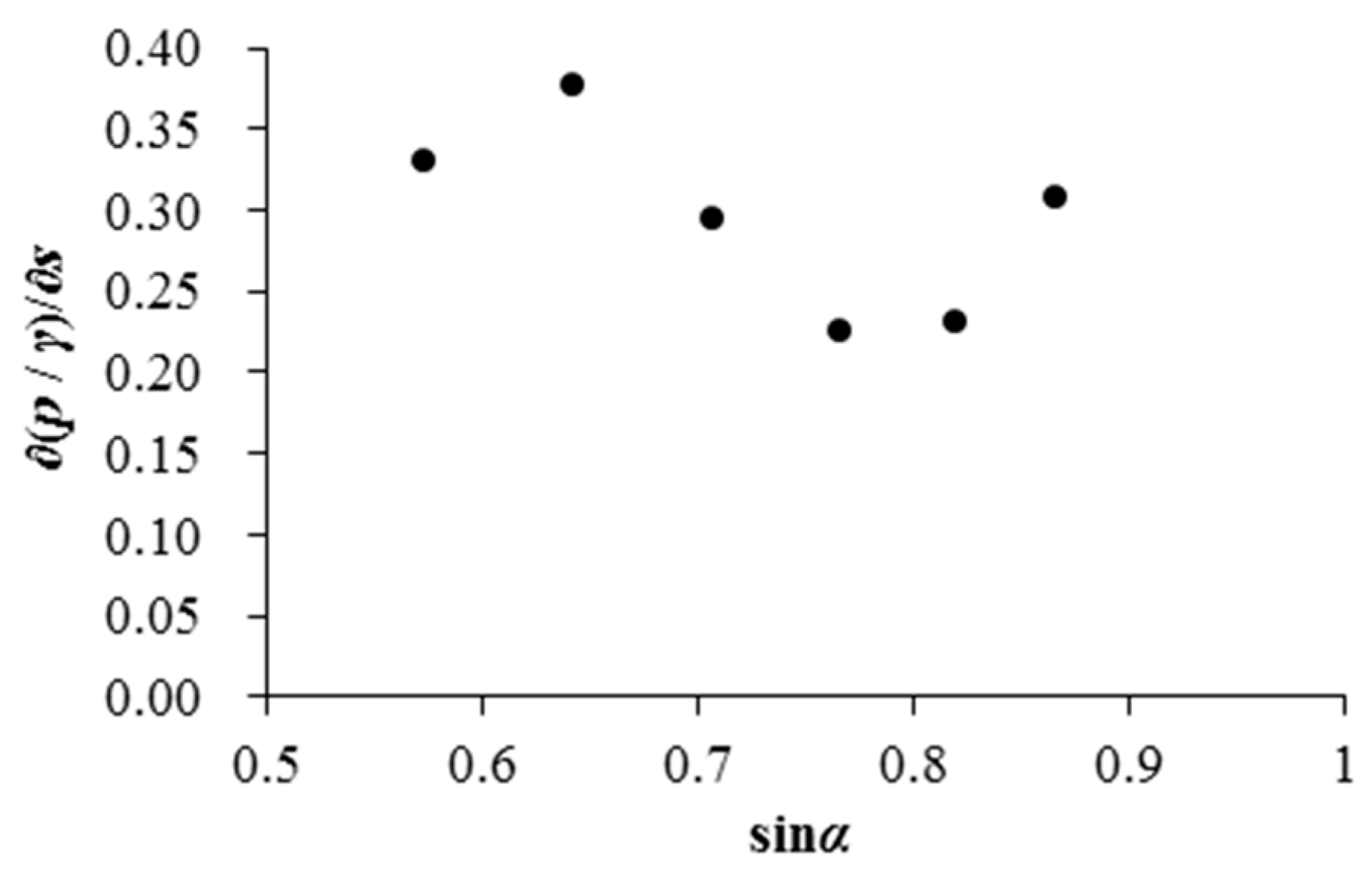
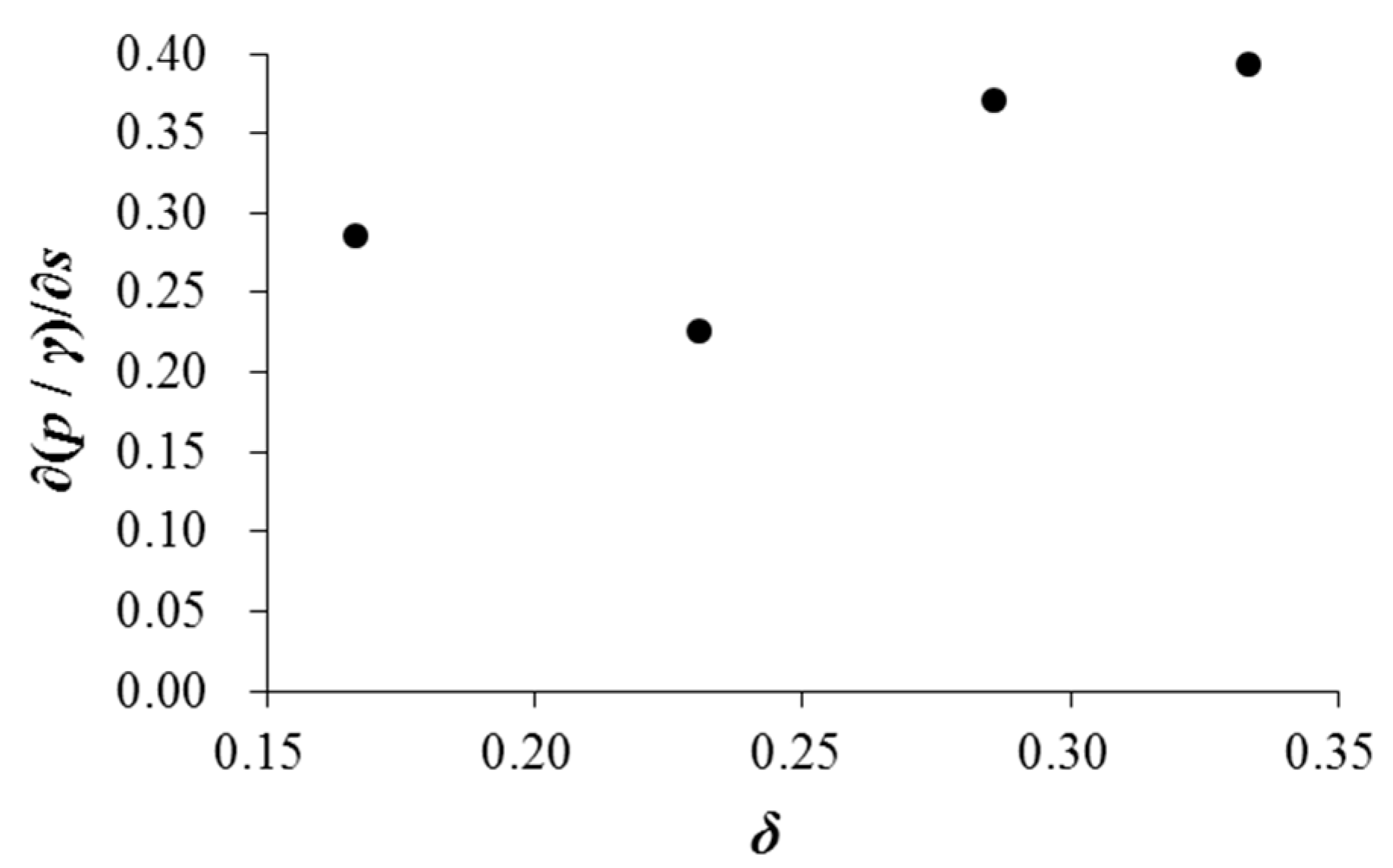
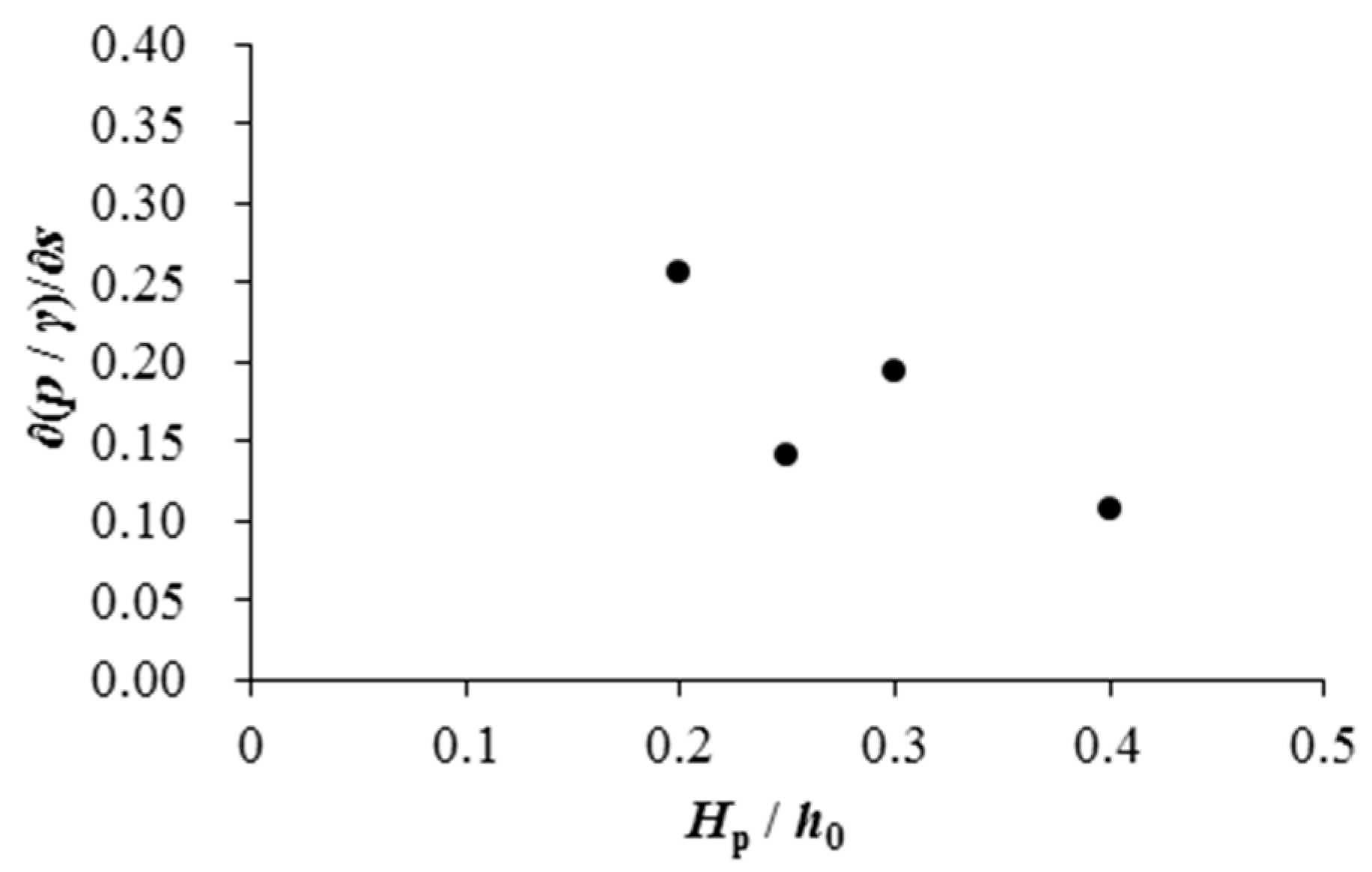
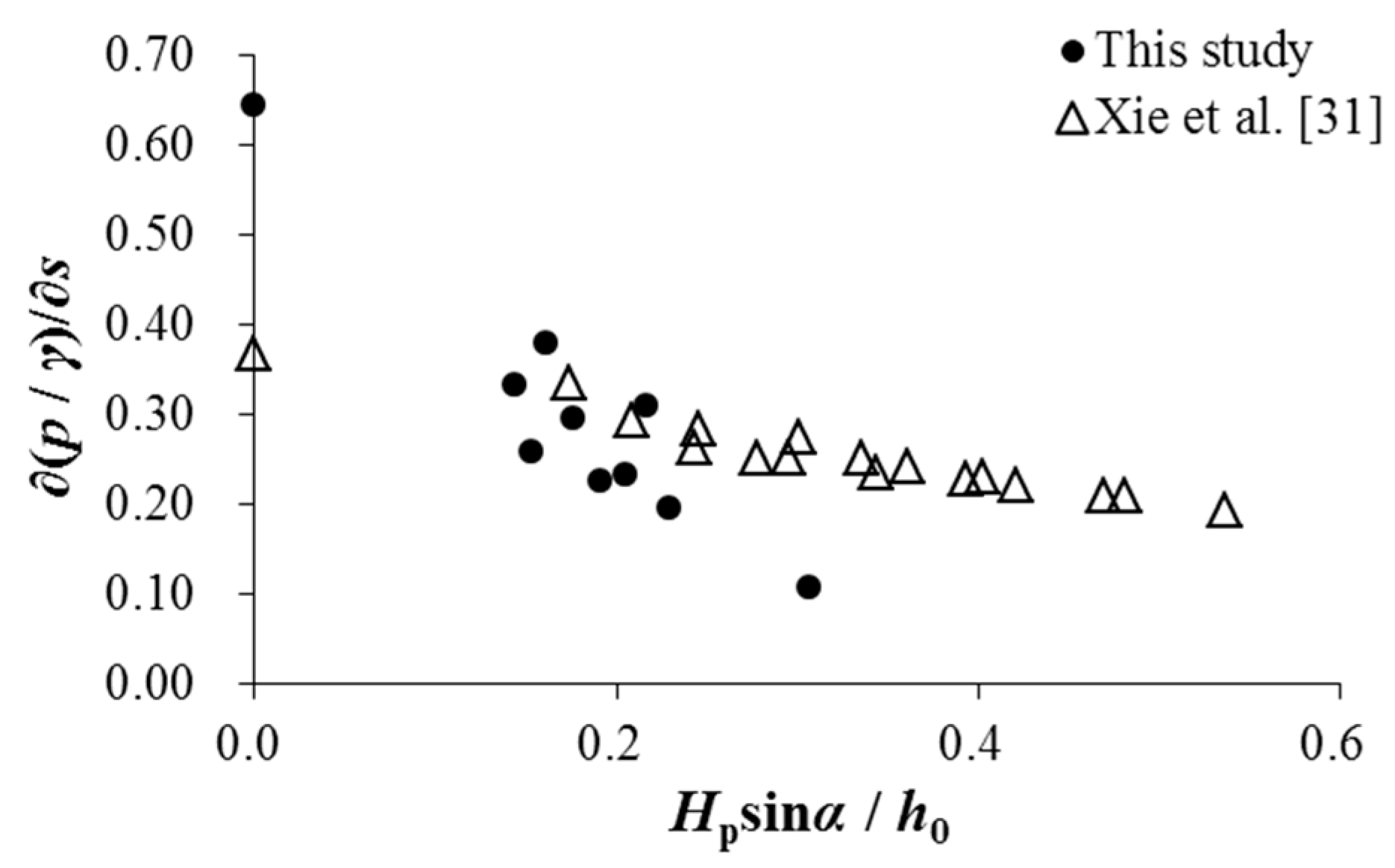
| Group | Case | Sloping Angle α (°) | Opening Ratio δ | Plate Height Hp (m) |
|---|---|---|---|---|
| A | A1 | Control test, without GMFP | ||
| B | B1 | 35 | 0.231 | 0.10 |
| B2 | 40 | 0.231 | 0.10 | |
| B3 | 45 | 0.231 | 0.10 | |
| B4 | 50 | 0.231 | 0.10 | |
| B5 | 55 | 0.231 | 0.10 | |
| B6 | 60 | 0.231 | 0.10 | |
| C | C1 | 50 | 0.167 | 0.10 |
| B4 | 50 | 0.231 | 0.10 | |
| C3 | 50 | 0.286 | 0.10 | |
| C4 | 50 | 0.333 | 0.10 | |
| D | D1 | 50 | 0.231 | 0.08 |
| D2 | 50 | 0.231 | 0.10 | |
| D3 | 50 | 0.231 | 0.12 | |
| D4 | 50 | 0.231 | 0.16 | |
| Case | With GMFP | Scour Depth (cm) | Averaged Seepage Hydraulic Gradient ∂(p/γ)/∂s |
|---|---|---|---|
| A1 | No | 6.5 | 0.643 |
| B4 | Yes | 0 | 0.225 |
© 2020 by the authors. Licensee MDPI, Basel, Switzerland. This article is an open access article distributed under the terms and conditions of the Creative Commons Attribution (CC BY) license (http://creativecommons.org/licenses/by/4.0/).
Share and Cite
Zhu, Y.; Xie, L.; Su, T.-C. Scour Protection Effects of a Geotextile Mattress with Floating Plate on a Pipeline. Sustainability 2020, 12, 3482. https://doi.org/10.3390/su12083482
Zhu Y, Xie L, Su T-C. Scour Protection Effects of a Geotextile Mattress with Floating Plate on a Pipeline. Sustainability. 2020; 12(8):3482. https://doi.org/10.3390/su12083482
Chicago/Turabian StyleZhu, Yehui, Liquan Xie, and Tsung-Chow Su. 2020. "Scour Protection Effects of a Geotextile Mattress with Floating Plate on a Pipeline" Sustainability 12, no. 8: 3482. https://doi.org/10.3390/su12083482
APA StyleZhu, Y., Xie, L., & Su, T.-C. (2020). Scour Protection Effects of a Geotextile Mattress with Floating Plate on a Pipeline. Sustainability, 12(8), 3482. https://doi.org/10.3390/su12083482






